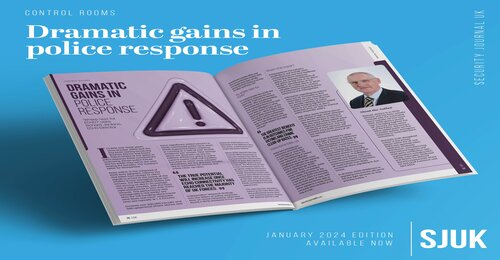The BSIA has been working closely with the FIA and the Fire and Security Association to develop ECHO, which aims to combine current call handling systems into one nationally recognised solution.
Unwanted alarm signals have been exercising police and fire services' call handling for many years, and in order to tackle the ongoing problem these service have been taking radically different approaches. Using different forms of technology to fit their requirements, the police have adopted a national approach providing a Unique Recognition Number (URN) to systems that have been installed to accredited third party validated standards, whereas the fire and rescue services has adopted a whole range of approaches, from non-attendance to any call from an Alarm Receiving Centre (ARC), to full attendance of all such calls.
Thought initially ECHO will focus on the call handlign process from ARCs to the emergency services, it will bring about the ability to automate Police URN Management as well as exploit the potential for delivering both automated audio and visual alarm confirmation. Despite the fact a similar service has been successfully piloted for some time with a limited number of alarm companies and police forces, the ECHO project has apirations in enabling technology to be rolled out to other police and fire control rooms.
The problem with the current system's capability is that it is a manual operation, which leads to the possibility of human error and delays in responding to emergency service incident response. The ECHO project teams proposal is to move from manual response handling to a centralised fully automated end-to-end electronic handling ability, aimed at reducing call handling times and the incidence of error, while alleviating pressure on the emergency services and the aforementioned ARCs. The migration to an electronic medium has the potential to also add value by providing a realistic opportunity to apply and manage URNs online.
The eventual ECHO service is expected to be subscription-based, most likely calculated annually on the number of URNs managed by ARCs and will be managed online. This will ensure that the operation of ECHO can be sustained year on year, consistently delivered by industry partners.
Following discussions between the National Police Chiefs Council (NPCC) and private security industry, the decision to implement electronic transfer has been agreed meaning the NPCC security systems policy citing a date on 2020 for all ARCs to be operating on an electronic platform. The project hopes that by 2020 for all ARCs to be operating on an electronic platform. The project hopes that by 2020 a full technical requirement specification for the ECHO system, including a viable financial operating model for the company and a project plan for the delivery of the operating company will be fully operational.
The first phase of ECHO will automate the current phone call from the ARC to the emergency services as a digital electronic machine to machine event. Once confirmation that the alarm has been received and understood, a signal will be sent from the responding service (also as a machine to machine event), back to the ARC. This will also provide for the responder's key holder information being tagged in the alarm event. The responding service will send an event close/stop message with an outcome to the ARC via machine to machine.
The second phase will look to automate the URN management, including application, approval and payment system possibly via a cloud base application process. This will improve the efficiency and accuracy of data to ensure it is consistent between installers, ARCs and the emergency services. Later phases proposed include; system enhancement to send additional event traffic information about the event i.e. roller shutter door (open rear of property), or a fire alarm (zone 3 third floor of building) and a further enhancement to phase 3 enabling further live situation data to be presented from typically video or audio equipment from the premises.
ECHO represents a real opportunity to generate significant savings in emergency response resources, both through fewer errors being made and a potential increase in the effectiveness of the emergency response by all partcipating services. Taking the longer view it's potential is immense, with critical infrastructure across all sectors of society, from hospitals to heritage all potentially benefitting from enhanced alarm transmission that offers all services to benefit from reduced false alarms.
Unwanted alarm signals have been exercising police and fire services' call handling for many years, and in order to tackle the ongoing problem these service have been taking radically different approaches. Using different forms of technology to fit their requirements, the police have adopted a national approach providing a Unique Recognition Number (URN) to systems that have been installed to accredited third party validated standards, whereas the fire and rescue services has adopted a whole range of approaches, from non-attendance to any call from an Alarm Receiving Centre (ARC), to full attendance of all such calls.
Thought initially ECHO will focus on the call handlign process from ARCs to the emergency services, it will bring about the ability to automate Police URN Management as well as exploit the potential for delivering both automated audio and visual alarm confirmation. Despite the fact a similar service has been successfully piloted for some time with a limited number of alarm companies and police forces, the ECHO project has apirations in enabling technology to be rolled out to other police and fire control rooms.
The problem with the current system's capability is that it is a manual operation, which leads to the possibility of human error and delays in responding to emergency service incident response. The ECHO project teams proposal is to move from manual response handling to a centralised fully automated end-to-end electronic handling ability, aimed at reducing call handling times and the incidence of error, while alleviating pressure on the emergency services and the aforementioned ARCs. The migration to an electronic medium has the potential to also add value by providing a realistic opportunity to apply and manage URNs online.
The eventual ECHO service is expected to be subscription-based, most likely calculated annually on the number of URNs managed by ARCs and will be managed online. This will ensure that the operation of ECHO can be sustained year on year, consistently delivered by industry partners.
Following discussions between the National Police Chiefs Council (NPCC) and private security industry, the decision to implement electronic transfer has been agreed meaning the NPCC security systems policy citing a date on 2020 for all ARCs to be operating on an electronic platform. The project hopes that by 2020 for all ARCs to be operating on an electronic platform. The project hopes that by 2020 a full technical requirement specification for the ECHO system, including a viable financial operating model for the company and a project plan for the delivery of the operating company will be fully operational.
The first phase of ECHO will automate the current phone call from the ARC to the emergency services as a digital electronic machine to machine event. Once confirmation that the alarm has been received and understood, a signal will be sent from the responding service (also as a machine to machine event), back to the ARC. This will also provide for the responder's key holder information being tagged in the alarm event. The responding service will send an event close/stop message with an outcome to the ARC via machine to machine.
The second phase will look to automate the URN management, including application, approval and payment system possibly via a cloud base application process. This will improve the efficiency and accuracy of data to ensure it is consistent between installers, ARCs and the emergency services. Later phases proposed include; system enhancement to send additional event traffic information about the event i.e. roller shutter door (open rear of property), or a fire alarm (zone 3 third floor of building) and a further enhancement to phase 3 enabling further live situation data to be presented from typically video or audio equipment from the premises.
ECHO represents a real opportunity to generate significant savings in emergency response resources, both through fewer errors being made and a potential increase in the effectiveness of the emergency response by all partcipating services. Taking the longer view it's potential is immense, with critical infrastructure across all sectors of society, from hospitals to heritage all potentially benefitting from enhanced alarm transmission that offers all services to benefit from reduced false alarms.





